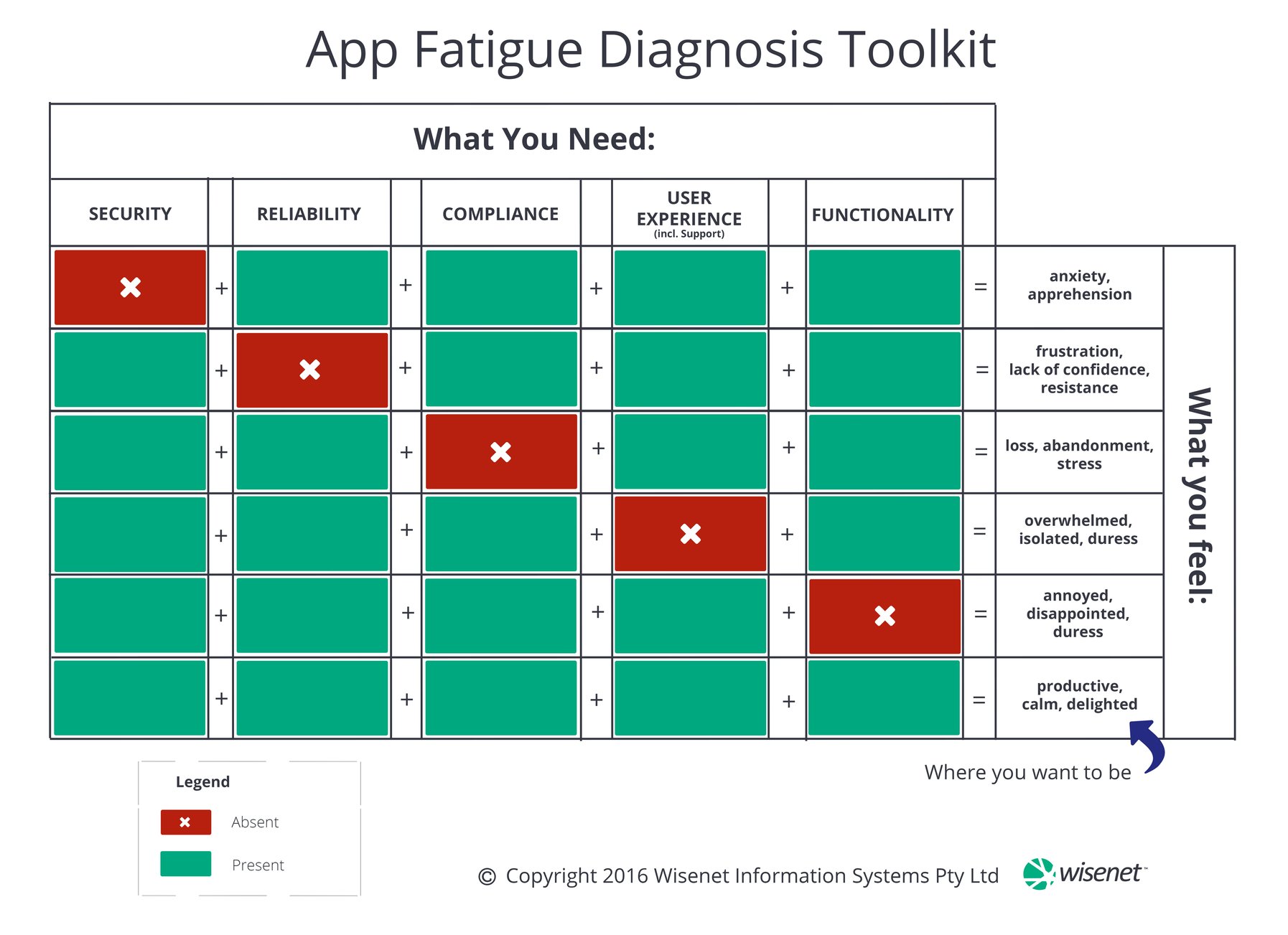
The way you’re feeling about the cloud application(s) you’re using reveals a lot about the vendor, and the resulting feelings highlight what’s missing from the ideal experience.
If you experience negative feelings about an application you use at work, you're not alone.
App Fatigue has become as common as gum disease - so common, it's a condition that's largely ignored with dis(App)ointment brushed off like houseflies.
Fact is, diagnosing App Fatigue could be as clinical and straightforward as your next doctor's visit. You'll be happy to know that you're well on your way to prevention and cure.
Here are our tips on diagnosing App Fatigue and how to set yourself up for App Nirvana instead!

In our conversations with clients and interested buyers, we've found that most people don't know how to compare vendors. The focus of our pre-sales conversations is inevitably functions for student management -- which are important, no doubt -- but that's just the tip of the iceberg!
Because of the Iceberg Problem, we've also met people who were experiencing Cloud App Fatigue and were skeptical about the security and reliability of the Cloud in general. The key indicators they mentioned were weak adoption of the application(s), lack of security, unreliable systems, and a poor return on investment.
Their stories go to show that it's pointless and even risky to have loads of fancy functions without security and reliability.
Choose the wrong vendor and you risk feelings of apprehension, anxiety, and constant frustration, along with loss of data integrity and other problems your cloud isn't supposed to have.
1. Make Security Job Zero
When choosing the right cloud app vendor, ensuring data security must be your first step in assessing any application. This is a step that many of our clients have failed to take in their early adoption of the cloud.
Failure to do so will result in anxiety and apprehension throughout your entire subscription, and could also put your entire organisation at risk.
It’s not enough to have the vendor tell you, “Our platform is secure.” You need them to show you how secure your data will be, and how they will stand behind any statements or claims they may make.
As custodians of your confidential data, cloud app vendors must build trust. At Wisenet, we build trust and allay fears by being transparent in all aspects like pricing, uptime, legal, support, and so on.
Being transparent requires publicly accessible security statements that detail:
- User Rights/Permissions and Access
- Multi-factor Authentication
- Audit Trails and Change History
- Confidentiality of Data
- Protection against vulnerability
- Encryption
- Data Availability (Backups and Redundancy)
- Notification Policy of Security Breaches (both past and future)
- Insurance for Security Breaches
This approach has enabled us to build trust with training providers who work with us.
Related: 3 Ways Registered Training Organisations Can Build Trust To Grow Revenue
How to get the right answers:
Get on your app vendor's website and make sure each of these aspects of security are adequately addressed. The end goal is to remove any anxiety you may have, and get rid of any doubt that your training organisation's data is kept safe and secure.
2. Take A Reliability Check
Ensuring reliability is the next step towards risk management. Your data might be secure, but if you're going to unexpectedly lose access to your data -- or if functions don't work as expected each and every time -- there's going to be more than frustration and damaged confidence.
Indicators of an unreliable vendor include:
- High frequency of bugs and errors
- Inconsistencies in data
- Slow response times
- Frequent crashes and unscheduled downtime
- No notifications prior to scheduled maintenance
Other indicators include:
- Your own feelings, like frustration, lack of confidence, and resistance.
The last set of indicators will only surface after you're locked in for a year-long contract and paid for the subscription in full. Don't let yourself go there...
Related: What VET Fee Help Providers Can Learn From The Volkswagen Scandal
How to get the right answers:
A health dashboard is essential to prove historical and current uptime. If your vendor fails to publish uptime, they're probably incompetent or don't care enough to measure their own reliability. Perhaps they just don't want you to know how how bad things actually are!
Either way, its a significant risk and should such vendors should be avoided. Be sure to also check for release notes detailing historical updates.
3. No Compliance, No Go!
Don't learn this the hard way!
Choosing and buying non-compliant software for your business is almost like depositing money in a bank with no guarantee of return, or buying stock shares with depreciating value.
Standards compliance for training providers is essential for initial registration, funding, quality assurance, and future audits. A student management system that doesn't help you do that will leave you feeling lost, abandoned, and stressed out.
How to get the right answers:
Start your shortlist by looking through compliant software registers published by regulatory bodies. These registers are usually available online and provide details of certified software that you can use for reporting and correct formatting.
Training providers, here are some lists you might find useful:
AVETMISS Compliant Software Register (Australia)
Certified Student Management Systems (New Zealand)
CPE's Recommended School Management Systems (Singapore)
A good student management system (SMS) shouldn't just boost your administrative productivity or data accuracy; it should also provide robust export options for your compliance reports (e.g. AVETMISS reports) and also validate your student data.
4. Define Your User Experience
User Experience isn’t just about design or application structure; most of us forget that this extends to the realms of Customer Support. Poor user experience will only result in duress and a sense of isolation.
The quality of User Experience and Support provided by the vendor will define the success (or even failure) of your projects and record management.
How to get the right answers:
Take a litmus test for the quality of Customer Support: leave an enquiry with the vendor you're considering. The length of the response time could give a clue about the level of User Experience and Customer Support offered.
Bear in mind that this is only an indicator, not evidence of quality - some vendors are more focused on new sales rather than servicing existing customers! Customer service and support are usually handled by different teams, and your consistent experience with both hinges on the company's culture.
Here are some examples of indicators to examine to help determine what kind of user experience you're going to get:
Sales:
- Transparent, publicly accessible Pricing
- Publicly accessible Terms & Conditions
- Option for Free Trial
- Features and Benefits, clearly illustrated and detailed on public website
Onboarding Support:
Post-Onboarding Support:
- Publicly accessible Help or Resource Centres
- Blogs to help you run your business better (like this one!)
- Phone Hotlines
- Online Helpdesks
- Screen Sharing support sessions
- Instant Messaging (within the app or website)
- Webinars
5. Compare Features - They're Not All The Same!
When buying a cloud application, the lack of features and functions might cause dis(App)ointment and annoyance, and that's the main showstopper for most buyers who won't even bother signing up.
Even when buyers have found features that they want, most are willing to acquiesce or take features at face value when buying/subscribing to an app because of the common (and dangerous) misconception that all vendors are the same.
But they're not.
There are many ways in which a feature can be implemented, and the degree of configuration and the possible actions you can take with each feature vary with each platform, and this can have an impact on your business processes, student lifecycle, and overall success.
It's just like buying a car. Nearly all brands claim to offer spacious, comfortable sedans with smooth engines, but we all know that each brand offers different levels of fuel savings, comfort, and safety.
Just as a car should make your road trips smoother, your cloud-based student management system should be certified and make your job easier, not more difficult or more risky.
Related: The Automation Tool That Every VFH Provider Needs
How to get the right answers:
Make a list of functions you need, and find the vendor’s pricing matrix that lists details of what you’ll get with your subscription.
As a best practice, vendors tend to have such details published on their websites.
Here’s what it should look like:

Key Takeaway:
Let’s face it: most apps today don’t always leave us feeling productive, calm, and delighted. Choosing the right cloud application vendor is also challenging because they're not all the same.
Functionality might be the first instinctive step that buyers want to take, but failure to consider other crucial aspects of cloud applications can put your entire business at risk.
Take a few steps back, look at the big picture to avoid app fatigue, and never rush into any purchasing decision without the information you need.
Good luck!
Know of other aspects that aren't listed here? Tell us in the comments and we'll add to the list!



COMMENTS